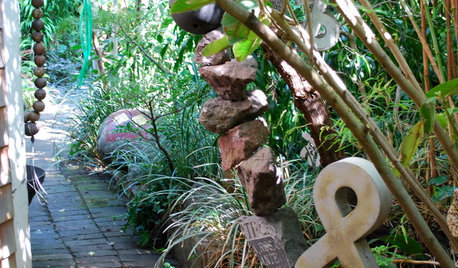Looking to find some names
LibbyLiz
14 years ago
Related Stories

LIFEYou Said It: ‘Name Your Garden’ and More Ideas of the Week
Design advice, inspiration and observations that struck a chord this week
Full Story
DECORATING GUIDESFor Nursery Decor, What's in a Name?
10 ideas for turning your baby's name into sentimental nursery wall art
Full Story
FUN HOUZZ16 Creative Paint Color Names We Haven't Seen — Yet
Someday, the namers of new paint colors will finally run out of ideas. We're here to help
Full Story
GARDENING GUIDESWhat’s in a Name? See 6 Wildflowers That Aren’t ‘Weeds’ at All
Dispel the stereotypes of weeds and try these wildlife-supporting native wildflowers in your garden
Full Story
DECORATING GUIDESFind Your Design Style
Choose One of These 8 Home Photos to Find Your Signature Look
Full Story
ARCHITECTURELook Beyond the House to Find a Home
See how clever homeowners have put down stakes in a lighthouse, train depot, church, bourbon distillery, barn and missile silo
Full Story
DECORATING GUIDES1970s Style Finds Groove Today
The bright colors and unmistakable patterns of the '70s are swinging back into homes, but with modern flair for today's interior designs
Full Story
HOUSEPLANTSPlay Up Some Fiddleleaf Figs for a Lively Indoor Tune
Strike a dramatic chord in a minimalist scene or a country note in a rustic setting — fiddleleaf fig plants harmonize with any style
Full Story
KITCHEN DESIGNHow to Find the Right Range for Your Kitchen
Range style is mostly a matter of personal taste. This full course of possibilities can help you find the right appliance to match yours
Full StorySponsored
Central Ohio's Trusted Home Remodeler Specializing in Kitchens & Baths
More Discussions







LibbyLizOriginal Author
exoticrainforest
Related Professionals
Deer Park Landscape Architects & Landscape Designers · Oviedo Landscape Contractors · Pikesville Landscape Contractors · Suitland Landscape Contractors · Northlake Landscape Contractors · Artesia General Contractors · Eatontown General Contractors · Everett General Contractors · Lincoln General Contractors · Pico Rivera General Contractors · Redan General Contractors · San Carlos Park General Contractors · Honolulu Siding & Exteriors · Orange County Siding & Exteriors · Sacramento Siding & Exteriorsexoticrainforest